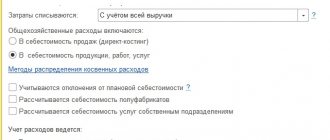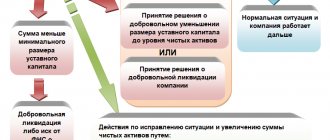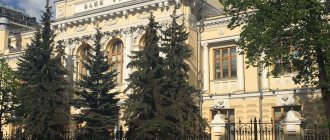Additional nuances:
Not possible for all legal forms.
The transferred funds cannot be taken into account as part of the costs of acquiring a share when receiving subsequent income (upon its sale, upon leaving the company or its liquidation). If the charter of the receiving party is standard and does not contain detailed norms, then contribution to the property is possible only in money and only in proportion to all participants (shareholders). If the charter is rewritten, then not all participants will be able to contribute to the property (or not in proportion to their shares of participation). In an LLC, the decision on a contribution to property is made by no less than 2/3 of the votes. In a joint stock company, making a contribution is possible on the basis of an agreement approved by the Board of Directors, or by decision of the general meeting of shareholders. The procedure for making a decision on making contributions to the organization’s property can also be worked out in detail in the corporate agreement.
The Tax Code provides for two preferential mechanisms
, which allow you to exempt inherently gratuitous contributions from taxation:
1) Gratuitous transfer of property and property rights on the basis of subclause 11, clause 1, article 251 of the Tax Code of the Russian Federation. It itself is possible in two forms:
- transfer of property in favor of an organization whose authorized capital directly and/or indirectly consists of at least 50% of the contribution of the transferring party (“mother”, “grandmother” or an individual participant (shareholder);
- "daughter's gift" This is a transfer from a subsidiary to the parent company, which directly and/or indirectly owns 50% or more of the authorized capital of the subsidiary.
2) Contribution to the property of a business company or partnership from its participant or shareholder, regardless of the share of participation. 3.7 clause 1 art. 251 NK Let's look at the mechanisms in detail. Moreover, since 2022, significant changes have been made to them.
Gratuitous transfer of property under clause 11, clause 1 of Art. 251 Tax Code of the Russian Federation
Firstly, the contribution can be property and, from November 23, 2020, property rights. Cash refers to property, non-cash money refers to property rights. Art. 128 Civil Code of the Russian Federation
Exemption from taxation in accordance with paragraphs. 11 clause 1 art. 251 of the Tax Code also applies to debt forgiveness. Letter from the Ministry of Finance of Russia dated December 14, 2015 No. 03-03-07/72930; Resolution of the Arbitration Court of the Central District dated January 27, 2015 in case NoA23-1634/2014
Secondly, it is impossible to transfer them to third parties within one year from the date of receipt of property, property rights (except for funds).
In other words, significant restrictions are imposed on the use of property: you cannot sell it, rent it out, or otherwise dispose of the received property, as well as assign property rights. The logic of the legislator is clear - some kind of assistance from a participant in his company is exempt from taxation, because he transferred the property (property right) for its use, and not for renting or assignment.
The undoubted “trick” of this tax-free basis is the opportunity, from 2022, to make a contribution to the property not only from a direct participant, but also from a person who has an indirect share of participation through an intermediate company. For a contribution to be exempt from taxation, the share of indirect participation must also be at least 50%.
To calculate the share of indirect participation, it is necessary to multiply the shares of direct participation in each organization along the ownership chain. For example:
"Daughter's Gift"
The Tax Code allows tax-free transfer of property not only from “mother” or “grandmother”, but also in the opposite direction - from “daughter” to or to.
Exemption is provided under sub-clause 11, clause 1 of Article 251 of the Tax Code, subject to compliance with an important condition - the direct and/or indirect share of the parent company in the authorized capital of the subsidiary is at least 50%. Important!
It will not be possible to transfer a “child gift” to an individual participant without taxes. Such payment will be equivalent to dividends. A “subsidiary gift” in some cases is an alternative to paying dividends when the conditions for a tax-free transfer of profit from a subsidiary to the parent organization are not met, in particular:
- the holding period of 365 days has not been met;
- in addition to the majority participant with a share of 50% or more, there are minority shareholders,
- “distribute profits” in favor of whom you do not want: dividends are distributed in most cases proportionally, and such a requirement is not imposed on a “child gift”.
It is necessary to distinguish a “daughter gift” (we ourselves came up with such a name, it is not in the Civil Code) from a gift agreement, which is prohibited between commercial organizations. 575 of the Civil Code of the Russian Federation. Gifting is an agreement, a bilateral transaction, the recipient of which can easily refuse to enter into it (you have a felt-tip pen and you give it to a friend... and the friend responds: “you know where to go, with your felt-tip pen). A “child gift” is a corporate relationship. Unlike our children, a subsidiary cannot refuse to fulfill the will of the parent company.
For the meticulous:
“Economic relations between the main and subsidiary companies may involve not only investments of the main company in the property of the subsidiary at the stage of its establishment, but also at any stage of its activity. In addition, economic feasibility in relations between a subsidiary and the main company may necessitate the reverse transfer of property. At the same time, the absence of direct reciprocity is a feature of the relationship between the main and subsidiary companies, which from an economic point of view represent a single economic entity.”
Resolution of the Presidium of the Supreme Arbitration Court of the Russian Federation
Contribution to property according to paragraphs. 3.7 clause 1 art. 251 Tax Code of the Russian Federation
pp. 3.7. clause 1 art. 251 of the Tax Code allows the investments of participants, both in the form of property and in the form of property or non-property rights, to be exempt from taxation. In this case, the size of the participant’s share does not matter.
For the meticulous:
Article 251. Income not taken into account when determining the tax base 1. When determining the tax base, the following income is not taken into account: <...>
3.7) in the form of property, property rights or non-property rights in the amount of their monetary value, which are received as a contribution into the property of a business company or partnership in the manner established by the civil legislation of the Russian Federation.
The provisions of this paragraph apply to virtually any method of increasing property, including increasing the assets of the company in the form of transfer of things, cash, shares/shares in companies or securities, or, for example, rights of claim under an assignment agreement.
! Clause 3.7 clause 1 of Article 251 of the Tax Code of the Russian Federation is relatively new and appeared in the Tax Code only in 2022. It replaced the famous clause 3.4, which was popularly called “contribution to increase net assets.” Clause 3.7 has a more concise content, referring to civil legislation - you can convey everything that is permitted by the Civil Code of the Russian Federation and special laws. The main thing is to provide for this in the individual charter of the company. Resolution of the Arbitration Court of the North Caucasus District dated 07/07/2020 in case No. A63-16832/2019
However, this method of tax-free transfer also has its limitations:
- Property, property or non-property rights can only be transferred from a participant (shareholder) to the relevant business company. That is, transfer in the opposite direction - from the subsidiary to the parent company - is impossible.
- Contributions to property are only possible in relation to business companies or partnerships. For example, such a contribution cannot be made to a production cooperative without tax consequences.
As we have already mentioned, sub. 3.7. clause 1 art. 251 of the Tax Code of the Russian Federation replaced subclause 3.4, which directly provided for the possibility of contributing to property by forgiving a debt by a participant in his organization. Currently there is no such clarification, although the possibility is still relevant.
Let's figure out whether it is now possible to forgive debt without taxes.
When the share of participation is 50% or more, then we can confidently refer to paragraphs already known to us. 11 clause 1 art. 251 Tax Code of the Russian Federation. If the share of participation in a subsidiary is less than 50%, then we can only be guided by clause 3.7, clause 1, article 251 of the Tax Code of the Russian Federation.
Neither the Ministry of Finance of the Russian Federation nor the courts have yet voiced their position directly.
We believe that you can get out of the situation in this way:
- At the first stage, the participant (shareholder) or the general meeting, as before, decides to make a contribution to the property. But not in the form of debt forgiveness, but by transferring funds, the amount of which is exactly equal to the debt formed to him (for example, the amount of an unrepaid loan). Makes a decision, but does not implement it.
- At the second stage, the participant (shareholder) - creditor signs an agreement with the subsidiary to offset counterclaims (in our example with a loan - obligations to repay the loan and make a cash contribution). As a result, the subsidiary's obligation to the participant is extinguished tax-free.
To be on the safe side, in the charter of a subsidiary company, as well as when applying subclause 3.4, which has become invalid, it is advisable to include a provision on the possibility of making contributions to property not only in money.
Minuses. VAT.
If the contribution to the property is made by the organization on the OSN and the property is transferred, then the “mother” must restore VAT from the residual value of the property. In this case, the restored value added tax can be included in expenses.
And the receiving party will not be able to deduct VAT, since it did not pay money for this property (remember that a contribution to property is a type of gratuitous transfer). Therefore, a property contribution is more suitable for transferring funds.
Where is the mistake
When making a contribution to the authorized capital of another company, invoices are not drawn up. Indeed, according to the code, the transfer of property to the authorized capital is not recognized as a sale and is not subject to VAT (subclause 4, clause 3, article 39, subclause 1, clause 2, article 146 of the Tax Code of the Russian Federation). However, the legislation allows the receiving party to deduct the tax that was restored by the founder (clause 11 of Article 171 of the Tax Code of the Russian Federation).
And in order for her to take advantage of this right, the founder must allocate the amount of the restored tax in the documents for the transfer of property. It is these papers (or their notarized copies) that the receiving company files in the journal of received invoices. It also registers in the purchase book at the time of registration of received assets (Resolution of the Government of the Russian Federation of December 2, 2000 No. 914).
If the founder did not allocate VAT as a separate amount in the accompanying documents, then it turns out that the receiving party loses the right to deduct this tax.
Example 1
In March 2008, the founder contributed equipment with an initial cost of 700,000 rubles to the authorized capital of Rus CJSC. VAT, which the founder at one time accepted for deduction, is 126,000 rubles.
The residual value of the object at the time of its transfer is 500,000 rubles.
Accordingly, the restored VAT on the residual value is:
500,000 rub. x 18% = 90,000 rub.
Let's assume that the agreed value of the equipment, confirmed by an independent appraiser, is also 500,000 rubles.
The founder issued an accompanying document to JSC Rus - an act of acceptance of the transfer of fixed assets in the OS-1 form (approved by Resolution of the State Statistics Committee of Russia dated January 21, 2003 No. 7). Here the shareholder indicated the cost of the fixed asset - 500,000 rubles.
At the same time, the transferring party did not reflect the restored VAT on a separate line.
Therefore, the accountant of ZAO Rus independently allocated VAT at the calculated rate:
500,000 rub. x 18%: 118% = 76,271 rub.
The following entries were made in the company's accounting:
DEBIT 75 CREDIT 80
— 500,000 rub. – the founder’s debt for transferring property to the authorized capital is reflected;
DEBIT 08 CREDIT 75
— 423,729 rub. (RUB 500,000 – RUB 76,271) – reflects the cost of equipment received as a contribution to the authorized capital;
DEBIT 19 CREDIT 75
— 76,271 rub. – VAT on the received equipment is taken into account;
DEBIT 01 CREDIT 08
— 423,729 rub. – the equipment has been put into operation;
DEBIT 68 subaccount “VAT calculations” CREDIT 19
— 76,271 rub. – accepted for deduction of VAT on the equipment received.
As can be seen from the example, the accountant not only unlawfully accepted VAT for deduction, but also distorted the initial cost of the received fixed asset.
HOW TO RETURN YOUR INVESTMENT IN PROPERTY
A contribution to property made by an individual participant is irrevocable: unlike a loan, it cannot be demanded back. Some kind of return on investments made is only possible in the form of dividends. The same as for investments in the form of a contribution to the authorized capital.
However, unlike contributions to the authorized capital, the amount of contributions made to property will not count towards the costs of acquiring a share (shares) upon subsequent sale of the share (shares), exit or liquidation of the company.
There is an exception for participants - organizations - this is the opportunity to return, without income tax, an amount equivalent to a previously made contribution to the property of a business company or partnership (LLC, JSC, general partnership) clause 11.1 clause 1 of Article 251 of the Tax Code of the Russian Federation
Mandatory requirements:
- The contribution must be made and returned exclusively in cash. If the initial contributions to the Company's property were made not with money, but with other property (buildings, land plots, equipment, shares (shares) in the authorized capital of the Company), then return these assets back to the participant who contributed them without paying tax on the basis of the provisions of paragraphs. 11.1 clause 1 art. 251 of the Tax Code of the Russian Federation will not work. Return of the deposit must also be made in cash. This eliminates situations of possible abuse associated with the disproportionality of the initial contribution and the method of its tax-free return.
- The tax exemption applies to the extent of the previously made contribution. The amount within which the exemption applies under Subsection 11.1, Clause 1, Article 251 of the Tax Code of the Russian Federation is limited by the amount of the previously made contribution. In this regard, it is important for the participant to keep documents that would confirm the amount of contributions they made. These include decisions (minutes) of the general meeting of participants and payment orders for the transfer of funds.
- It does not matter when the contribution was made. Tax-free returns are possible after 01/01/2019. The rule on tax exemption for the return of previously made contributions to property came into force on January 1, 2022. And it applies to all “old” contributions to property. The main requirement is their monetary form. This was confirmed by the Ministry of Finance of Russia. Letter of the Department of Tax and Customs Policy of the Ministry of Finance of Russia dated February 14, 2019 N 03-03-06/1/9345.
- Legal successors can also take advantage of the tax exemption.
The benefit also applies to legal successors - both the participating organization and the subsidiary. So, if a subsidiary company that received a contribution to the property was merged with another company, then this other company will also be able to return the funds to the participant.
All other conditions apply to legal successors - the availability of supporting documents and the monetary form of the initial deposit.
The decision on the return of previously made contributions to property is made by the general meeting of participants of the subsidiary organization.
For convenience, we have compiled a comparative table that will allow you to choose between two types of property deposits and a loan to obtain repayable financing
.
| Criteria | Loan | Free transfer of property under clause. 11. clause 1 of article 251 of the Tax Code of the Russian Federation | Contribution to property (subclause 3.7 clause 1 of article 251 of the Tax Code of the Russian Federation) |
| Who can receive funding | Any organization / individual entrepreneur | Only an organization that has an authorized/shared capital (JSC, LLC, business partnership/partnership) | Only business companies and partnerships (LLC, JSC, Full Partnership) |
| Who can provide financing | Any person:
| Direct or indirect participant/shareholder whose share is at least 50%. A reverse transfer is also possible - from a “daughter” or “granddaughter”, provided that the direct / indirect share of the receiving party is at least 50% | Only a member of society. The size of the share does not matter. We recommend establishing in the charter the ability to make contributions disproportionate to shares in the authorized capital |
| What is transmitted | Cash only (cash refers to property, non-cash refers to property rights) | Property, property rights | Property, property rights, non-property rights |
| Financing fee | Interest is accrued and paid at the market rate for the use of borrowed funds | Interest is not charged for the use of funds. | |
| Tax implications when providing financing | The loan amount is not taken into account in the lender's expenses and in the borrower's income. Loan interest is taxed by the recipient and taken into account as expenses by the payer (borrower) | The contribution to property is also not taken into account in the participant’s expenses and in the recipient’s income. | |
| Features of reflection in financial statements | The borrower develops accounts payable, which is sometimes negatively assessed by banks when analyzing the financial condition for issuing a loan. The lender has financial investments | The subsidiary generates “other income” and increases the retained earnings indicator, which has a positive effect when assessing its financial condition | |
| Tax risks | Challenging the borrowed nature of the relationship, if the actual relations of the parties do not correspond to market ones (interest is not paid, loan extension) | If the right to make contributions to property is provided for by the charter, the decision of the participants (shareholders) is drawn up correctly, then there are no tax risks | |
| Possibility of return | Loan repayment is its key characteristic. Loan repayment does not generate income for the lender and expenses for the borrower. The loan amount and interest are subject to repayment. | The possibility of a tax-free return of a contribution to property in cash within the limits of previously made contributions is provided for under clause 11.1, clause 1 of Art. 251 of the Tax Code of the Russian Federation from 01/01/2019 | |
VAT on transfer of property to the authorized (share) capital
Home — Articles
Deductions from a taxpayer who received property, intangible assets and property rights as a contribution (contribution) to the authorized (share) capital (fund) are subject to tax amounts that were restored by the shareholder (participant, shareholder) in the manner established by clause 3 of Art. 170 of the Tax Code of the Russian Federation, if they are used to carry out transactions recognized as objects of taxation in accordance with Chapter. 21 of the Tax Code of the Russian Federation (clause 11 of Article 171 of the Tax Code of the Russian Federation).
Considering that the transfer for investment purposes in accordance with Art. 39 of the Tax Code of the Russian Federation is not a sale; the transferring party does not draw up an invoice. The recovered VAT is indicated in the primary document used to formalize the transfer.
Explanations of the procedure for accounting for VAT when transferring property to the authorized capital are given in Letters of the Ministry of Finance of Russia dated October 30, 2006 N 07-05-06/262 (response to a private request) and dated December 19, 2006 N 07-05-06/302 “Recommendations for conducting audit of annual financial statements of organizations for 2006.”
Example 1. A joint stock company is registered with an authorized capital of 500,000 rubles. One of the founders, whose share is 210,000 rubles, pays for the shares by transferring a fixed asset with the following data:
— initial cost according to accounting and tax records — 300,000 rubles, VAT presented by the supplier in the amount of 54,000 rubles. upon commissioning was presented for deduction;
— residual value according to accounting data — 200,000 rubles. (revaluation was not carried out);
— residual value according to tax accounting data — 170,000 rubles;
— the cost of the fixed asset, agreed upon by the founders and confirmed by an independent appraiser, is 230,000 rubles;
— VAT subject to recovery by the transferring party—RUB 36,000. (RUB 200,000 x 18%: 100).
Reflection of transactions in the accounting and tax records of the transferor
| the name of the operation | Debit | Credit | Amount, rub. | Base |
| Reflects the debt for payment of shares as of the date of registration of the company | 58 | 76 | 200 000 | Certificate of registration of the company |
| The amount of restored VAT is reflected | 58 | 68 | 36 000 | Calculation |
| The residual value of the transferred fixed asset is written off | 76 | 01 | 200 000 | Act of Handover |
As can be seen from the table, the cost of shares in accounting is 236,000 rubles. (RUB 200,000 + RUB 36,000).
In tax accounting, the value of financial investments (shares) is equal to the residual value of the transferred fixed asset according to tax accounting, that is, 170,000 rubles.
We note that the issue of the possibility of including the amount of restored VAT in the tax value of financial investments by the transferring party of the Federal Tax Service of Russia and the Ministry of Finance of Russia has not been agreed upon.
Reflection of transactions in the accounting and tax records of the created company
| the name of the operation | Debit | Credit | Amount, rub. | Base |
| Debt on contributions to the authorized capital is reflected | 75 | 80 | 500 000 | Registration certificate |
| Including the share of the founder transferring the fixed asset | — | — | 210 000 | Register of shareholders |
| A fixed asset was accepted for accounting as payment for shares with a par value of RUB 210,000. in the assessment agreed upon by the founders | 08 | 75 | 230 000 | Act of Handover |
| The difference between the estimated and nominal values is attributed to additional capital | 75 | 83 | 20 000 | Calculation |
| VAT recovered by the transferring party is reflected | 19 | 83 | 36 000 | Shareholder calculation |
| The main facility has been put into operation | 01 | 08 | 230 000 | Commissioning certificate |
| VAT is deductible | 68 | 19 | 36 000 | Shareholder calculation and entry in the purchase book |
In accounting, the initial cost of a fixed asset contributed as a contribution to the authorized capital is reflected in the valuation agreed upon by the founders. The difference between the estimated value of the fixed asset and the nominal value of the shares is attributed to the company's additional capital (share premium). VAT recovered by the transferring party is accepted for deduction, taking into account the fact that the fixed asset will be used for operations subject to VAT.
How is VAT accepted for deduction by the receiving party taken into account for the purpose of calculating income tax?
On January 1, 2008, the amendment made to Art. 251 of the Tax Code of the Russian Federation by Federal Law of July 24, 2007 N 216-FZ.
The newly introduced paragraphs. 3.1 clause 1 of this article provides that when determining the tax base for income tax, income “in the form of amounts of value added tax subject to tax deduction from the receiving organization in accordance with Chapter. 21 of the Tax Code of the Russian Federation when transferring property, intangible assets and property rights as a contribution to the authorized (share) capital of business companies...".
The question arises: was it possible that before the introduction of this amendment, the amount of VAT restored by the transferring party in 2006 and 2007 was subject to income tax on the receiving party?
The tax authorities believe that the party who received the VAT deduction had an economic benefit, which was subject to income tax until 2008. The existence of such an approach is evidenced by arbitration practice.
Resolution of the Federal Antimonopoly Service of the Volga Region dated June 11, 2008 N A06-6758/2007-13
The tax authority believed that the amount of VAT is non-operating income of the enterprise and is subject to income tax, since the taxpayer has the right to a tax deduction for VAT without any costs.
This statement of the tax authority is based on an analysis of the provisions of Art. Art. 249 - 251 Tax Code of the Russian Federation. The list of income that is not taken into account when determining the tax base for income tax is contained in Art. 251 of the Tax Code of the Russian Federation is not subject to broad interpretation. The specified list does not indicate the type of income - the right to deduction. According to Art. Art. 249 and 250 of the Tax Code of the Russian Federation, any income not related to income from sales is recognized as non-operating income.
However, the court did not agree with this position.
According to paragraph 1 of Art. 277 of the Tax Code of the Russian Federation, the object of the tax base for income received in the form of a contribution (contribution) of property (property rights) to the authorized capital of an organization, for profit tax purposes is accepted at the cost (residual value) of the received property (property rights), determined according to tax accounting data from transferor on the date of transfer of ownership.
Based on the meaning of this norm, the recipient (issuer) in this case does not have a profit, just as the taxpayer does not directly have an object of taxation on profit.
Thus, one type of tax - income tax - cannot be charged on the amount of another tax - VAT. This type of taxation was not provided for by the tax legislation of the Russian Federation in force before January 1, 2008.
In addition, it is necessary to take into account the legal will of the legislator, who, in order to eliminate existing discrepancies in tax legislation, from January 1, 2008, paragraph 1 of Art. 251 of the Tax Code of the Russian Federation added paragraphs. 3.1, according to which the disputed amount is not subject to taxation.
The Supreme Arbitration Court of the Russian Federation, having considered the application of the tax inspectorate, did not find any grounds for reviewing the case in the manner of supervision. By ruling of the Supreme Arbitration Court of the Russian Federation dated October 21, 2008 N 13008/08, the transfer of the case to the Presidium of the Supreme Arbitration Court of the Russian Federation was refused.
Chapter 21 of the Tax Code of the Russian Federation defines only one option when VAT can be claimed for deduction.
What if the fixed asset is used for non-taxable transactions? Can “transferred” VAT be included in the initial cost of a fixed asset?
According to the author, if a fixed asset will be used for non-taxable transactions, then it cannot be included in the cost either in accounting or tax accounting.
In accounting, property received as a contribution to the authorized capital is taken into account in the valuation agreed upon by the founders. In tax accounting, the value of the transferred property is taken into account at the value of the transferring party according to tax accounting data. There is no provision for an increase in price by VAT. Therefore, the receiving party does not reflect the transferred VAT in both accounting and tax accounting (takes note).
VAT, VAT deduction
Fulfillment by a simplified person of the duty of a tax agent for VAT
Taxation of returned goods
VAT on the sale of real estate
VAT refund from the budget
How to fill out a VAT return for a tax agent
Instead of a summary, let us once again outline the MAIN THESIS:
- A property contribution is an expeditious method of tax-free transfer of funds and other property or property rights to a subsidiary. There is no need to visit a notary and make changes to the constituent documents, which is mandatory when increasing the authorized capital.
- The Tax Code of the Russian Federation provides for two preferential mechanisms - subclause 3.7 and subclause 11, clause 1, article 251 of the Tax Code of the Russian Federation. Each of them provides interesting opportunities, but is not without limitations. Therefore, we carefully read the law and choose the method that suits the specific situation.
- Do not forget that in order to make a contribution to property, the company’s Charter must provide for such an opportunity for its participants, including the opportunity to make contributions disproportionate to participation in the authorized capital, as well as with any property, property rights or through debt forgiveness.
- Clause 11, clause 1, Article 251 of the Tax Code of the Russian Federation also makes it possible to transfer it back - from a subsidiary to a participating organization (shareholder), whose direct and/or indirect share in the authorized capital is at least 50%. We called it the “daughter gift.” It can be an alternative to paying dividends, for example, when, in addition to the majority participant with a 50% share, there are minority shareholders in whose favor you do not want to “distribute profits”: dividends are distributed in most cases proportionally, and such a requirement is not imposed on a “child gift”.
- Parent organizations that previously made a cash contribution to the property of their “subsidiary” company can return it without incurring income tax.
What is authorized capital
This is the property of the organization, which was contributed by the owners. Capital can be formed by money, fixed assets, securities, materials, ownership and use rights and other assets.
The maximum amount is not limited. But at least 10,000 rubles are needed in money.
All founders make their contribution to the authorized capital of the LLC. The share determines how much weight his opinion will have when making decisions, how many dividends he will receive, what part of the property he will take during liquidation, etc.
The founders determine the deadline for contribution themselves. But there is a limitation - 4 months from the date of state registration of the organization. The tax office does not particularly monitor this and does not fine anyone, as it believes that this is the company’s business. However, by law, founders who have not contributed to the company must be excluded from the membership of the LLC.






